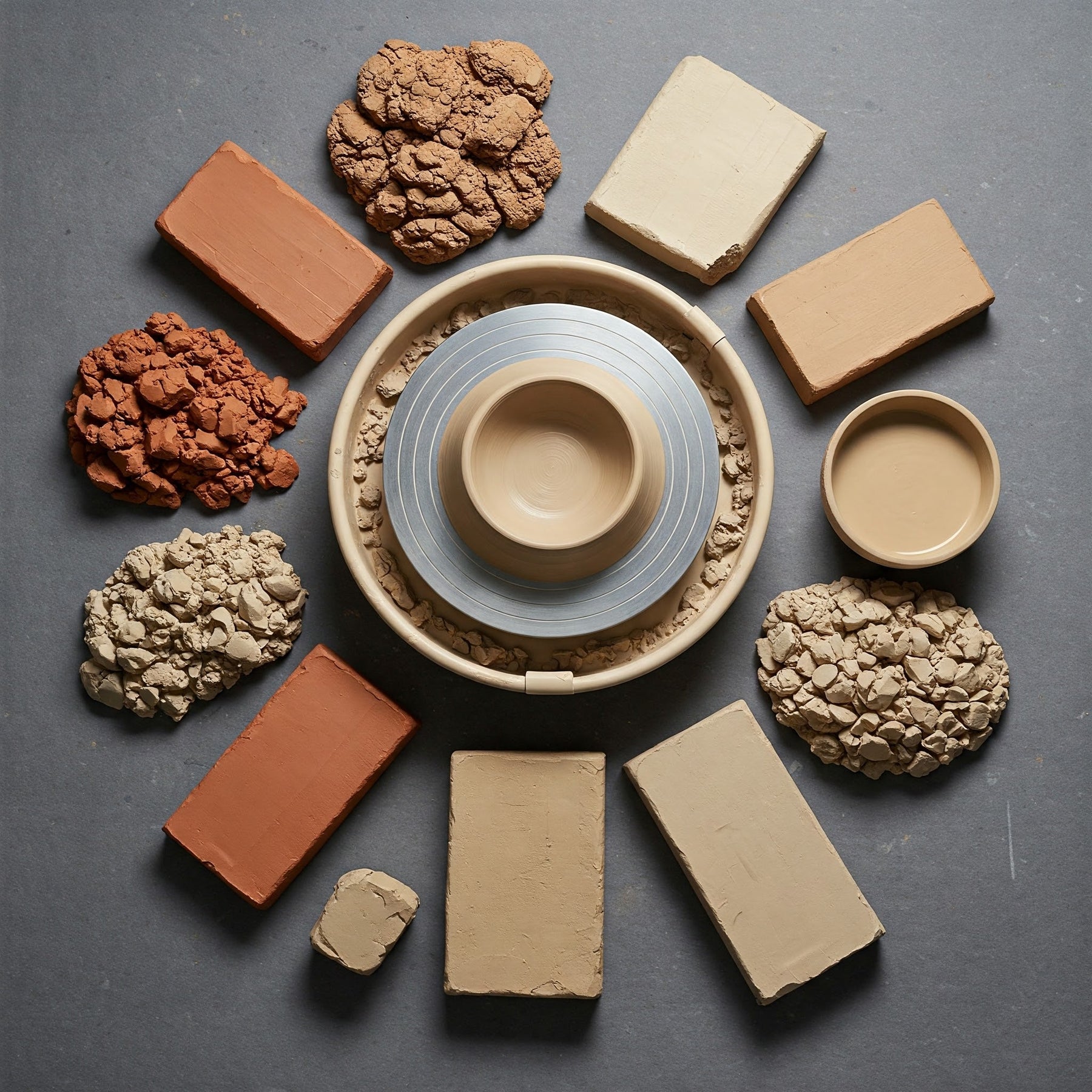
The Best Clay for Pottery Wheels: A Beginner’s Essential Guide
Spinning clay on Pottery Wheels is pure magic—until the wrong clay turns your masterpiece into a wobbly disaster! Short answer? Beginners love earthenware, pros swear by porcelain, and stoneware suits almost everyone. Keep reading for the best materials & tools, expert picks, and UK-friendly clay tips! 🎨🌀

Understanding Clay Types for Wheel Throwing
The best clay for throwing depends on how soft it is, how hot it needs to be fired, and how it feels in your hands. Here’s a breakdown of the most popular options.
Earthenware Clay
Characteristics and Best Uses
Earthenware is the go-to clay for beginners. It’s soft, easy to shape, and great for plant pots, decorative pieces, and rustic designs. It has a warm reddish tone and is widely available.
Firing Temperatures and Glazing
Fires at 1,000–1,200°C. It stays porous unless glazed, but it’s brilliant for colourful finishes.
Pros and Cons for Wheel Work
✅ Super forgiving and easy to work with
✅ Lower firing temperatures mean less energy use
❌ More fragile than other clays
❌ Chips more easily over time
Stoneware Clay
Characteristics and Best Uses
Stoneware is the all-rounder of pottery clays. It’s tough, holds its shape well, and is perfect for everyday items like mugs and plates.
Firing Temperatures and Glazing
Fires at 1,200–1,300°C. Once fired, it’s waterproof—even without glaze. Works well with matte and glossy finishes.
Pros and Cons for Wheel Work
✅ Durable and less prone to chipping
✅ Holds its shape well, great for functional pieces
❌ Needs higher kiln temperatures
❌ A bit stiffer to work with
Porcelain Clay
Characteristics and Best Uses
Porcelain is the clay of choice for fine tableware and delicate designs. It’s super smooth and can even have a translucent quality when thin.
Firing Temperatures and Glazing
Fires at 1,280–1,400°C. It’s vitrified (glass-like) after firing and can be left unglazed or given a glossy, refined finish.
Pros and Cons for Wheel Work
✅ Stunningly smooth finish
✅ Strong and durable after firing
❌ Hard to control on the wheel
❌ Prone to cracking and warping
Other Specialised Clays
Raku Clay
Used for bold, crackled, unpredictable finishes. Raku firing is fast and dramatic, but pieces aren’t usually watertight.
Paper Clay
Blended with paper fibres, making it lightweight and flexible. Great for sculpture but not always ideal for wheel throwing.
Key Factors to Consider When Choosing Clay
Plasticity and Workability
How Plasticity Affects Wheel Throwing
The more plastic a clay is, the easier it is to shape. Earthenware is highly plastic, while porcelain is less forgiving.
Testing Clay Plasticity
Roll a coil and bend it. If it cracks, it’s not very plastic. The best wheel-throwing clay bends easily without breaking.
Firing Temperature and Range
Matching Clay and Kiln Capabilities
Check that your kiln can reach the temperature needed for your clay. Low-fire kilns suit earthenware, while high-fire kilns handle stoneware and porcelain.
Understanding Cone Numbers
Kilns use “cones” to measure heat work. Earthenware fires at Cone 06, while stoneware and porcelain need Cone 6–10.
Texture and Grogg
Grogg's Role in Strength and Workability
Grogg (tiny fired clay particles) makes clay stronger and helps prevent cracking, but it also adds texture.
Smooth vs. Textured Clays
Smooth clays allow for intricate details, while grogged clays are better for large or sculptural work.
Colour and Finish
Natural Clay Colours
Clay comes in shades from white (porcelain) to buff, grey, and red (earthenware). The raw colour affects the final glazed look.
How Glazes Interact with Clay Colours
Glazes look different on various clay bodies. White clays make colours pop, while darker clays mute or change them.
Experience Level
Best Clay for Beginners
Soft, easy-to-shape earthenware is ideal for learning.
Clay for Advanced Techniques
Stoneware and porcelain challenge experienced potters with their durability and refinement.
Preparing Your Clay for the Pottery Wheel
Wedging Techniques
Importance of Wedging
Wedging removes air bubbles and makes the clay more even.
Different Wedging Methods
Try spiral wedging for consistency or ram’s head wedging for tough clays.
Moisture Content
Achieving the Right Clay Consistency
Clay should be firm but pliable. Too dry, and it cracks; too wet, and it collapses.
Reclaiming and Rehydrating Clay
Dried-out clay can be rehydrated with water and wedged back to life.
Troubleshooting Common Clay Issues on the Wheel
Cracking and Tearing
Causes and Solutions
Happens due to uneven drying or lack of wedging. Keep your clay moist and well-prepared.
Slumping and Collapse
Causes and Solutions
Too much water or poor structure causes collapse. Use grogged clay for large forms.
Uneven Walls and Thickness
Techniques for Consistent Forms
Even hand pressure and proper centring prevent wobbly, uneven walls.
Recommended Clay Brands and Suppliers
Popular Stoneware Brands
-
Valentine Clays
-
Potclays
-
Bath Potters’ Supplies
Reliable Porcelain Suppliers
-
Stoke-on-Trent Ceramics
-
Scarva Pottery
Finding Local Clay Suppliers
Check with pottery studios, craft stores, or online UK-based suppliers.
Frequently Asked Questions (FAQ)
Can I use air-dry clay on a pottery wheel?
No, it’s too weak and doesn’t hold up to throwing.
What is the difference between low-fire and high-fire clay?
Low-fire clays (earthenware) stay porous, while high-fire clays (stoneware, porcelain) become vitrified and waterproof.
How much clay do I need for a beginner project?
About 1–2kg is enough for small bowls or mugs.
Can I mix different types of clay?
Yes, but only if they have similar firing temperatures.
What tools do I need for working with clay on a wheel?
Basic tools include a wire cutter, sponge, rib, needle tool, and a bat.
Conclusion: Making the Right Clay Choice for Your Creative Journey
Finding the right clay is key to pottery success. Beginners should start with soft earthenware, while those wanting strength should explore stoneware. Porcelain is perfect for advanced potters ready for a challenge. Experiment, practice, and enjoy the process—the wheel is waiting for your next masterpiece!

